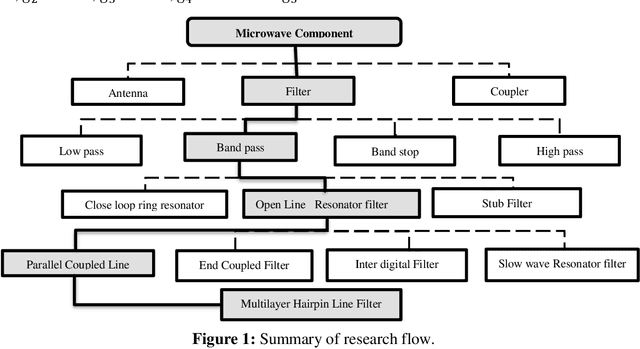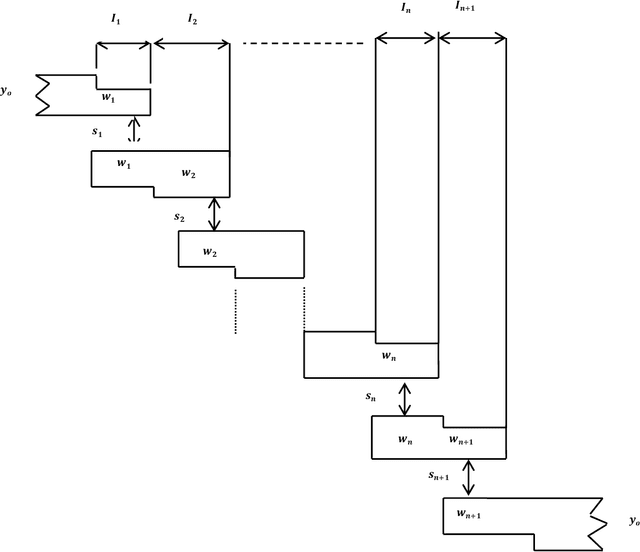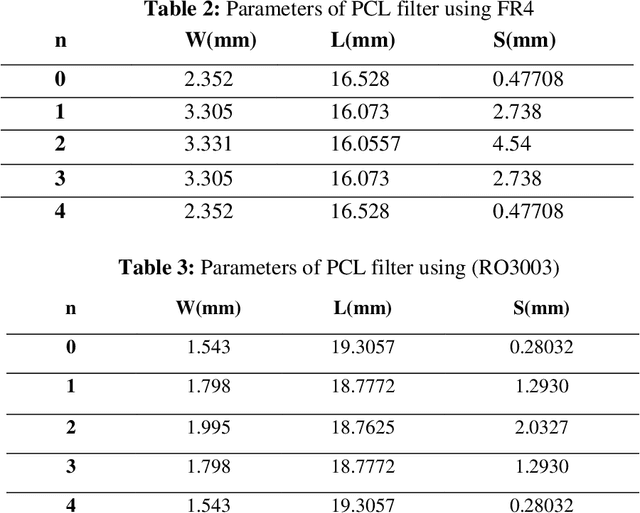Adeeb Salh
A Compact Size 5G Hairpin Bandpass Filter with Multilayer Coupled Line
Oct 07, 2021



Abstract:The multilayer structure is a promising technique used to minimize the size of planar microstrip filters. In the flexible design and incorporation of other microwave components, multilayer band-pass filter results in better and enhanced dimensions. This paper introduces a microstrip fifth-generation (5G) low-frequency band of 2.52-2.65 GHz using a parallel-coupled line (PCL) Bandpass filter and multilayer (ML) hairpin bandpass filter. The targeted four-pole resonator has a center frequency of 2.58 GHz with a bandwidth of 130 MHz. The filters are designed with a 0.1 dB passband ripple with a Chebyshev response. The hairpin-line offers compact filter design structures. Theoretically, they can be obtained by bending half-wavelength resonator resonators with parallel couplings into a "U" shape. The proposed configuration of the parallel-coupled line resonator is used to design the ML band-pass filter. The FR4 substrate with a dielectric constant ({\epsilon}r) of 4.3 and 1.6 mm thickness was used. A comparative analysis between the simulated insertion loss and the reflection coefficient of substrates RO3003 and FR4 was performed to validate the efficiency of the proposed filter design. Simulation of PCL filter is accomplished using computer simulation technology (CST) and an advanced design system (ADS) software. The PCL Bandpass filter was experimentally validated and a total tally between simulation results and measured results were achieved demonstrating a well-measured reflection coefficient. The simulated results obtained by the hairpin ML bandpass filter show that the circuit performs well in terms of Scattering(S) parameters and the filter size is significantly reduced.
Development of A Fully Data-Driven Artificial Intelligence and Deep Learning for URLLC Application in 6G Wireless Systems: A Survey
Aug 04, 2021



Abstract:The full future of the sixth generation will develop a fully data-driven that provide terabit rate per second, and adopt an average of 1000+ massive number of connections per person in 10 years 2030 virtually instantaneously. Data-driven for ultra-reliable and low latency communication is a new service paradigm provided by a new application of future sixth-generation wireless communication and network architecture, involving 100+ Gbps data rates with one millisecond latency. The key constraint is the amount of computing power available to spread massive data and well-designed artificial neural networks. Artificial Intelligence provides a new technique to design wireless networks by apply learning, predicting, and make decisions to manage the stream of big data training individuals, which provides more the capacity to transform that expert learning to develop the performance of wireless networks. We study the developing technologies that will be the driving force are artificial intelligence, communication systems to guarantee low latency. This paper aims to discuss the efficiency of the developing network and alleviate the great challenge for application scenarios and study Holographic radio, enhanced wireless channel coding, enormous Internet of Things integration, and haptic communication for virtual and augmented reality provide new services on the 6G network. Furthermore, improving a multi-level architecture for ultra-reliable and low latency in deep Learning allows for data-driven AI and 6G networks for device intelligence, as well as allowing innovations based on effective learning capabilities. These difficulties must be solved in order to meet the needs of future smart networks. Furthermore, this research categorizes various unexplored research gaps between machine learning and the sixth generation.
Optimal Transmit Power and Antenna Selection to Achieve Energy Efficient and Low Complexity in fifth generation Massive MIMO Systems
Jun 04, 2021
Abstract:This paper investigates joint antenna selection and optimal transmit power in multi cell massive multiple input multiple output systems. The pilot interference and activated transmit antenna selection plays an essential role in maximizing energy efficiency. We derived the closed-form of maximal energy efficiency with complete knowledge of large-scale fading with maximum ratio transmission while accounting for channel estimation and eliminated pilot contamination when the antennas approach infinity. We investigated joint optimal antenna selection and optimal transmit power under minimized reuse of pilot sequences based on a novel iterative low-complexity algorithm for Lagrange multiplayer and Newton methods. The two scenarios of achievable high data rate and total transmit power allocation are critical to the performance maximal energy efficiency. We propose new power consumption for each antenna based on the transmit power amplifier and circuit power consumption to analyze exact power consumption. The simulation results show that maximal energy efficiency could be achieved using the iterative low complexity algorithm based on the reasonable maximum transmit power when the noise power was less than the power received pilot. The proposed low complexity iterative algorithm offers maximum energy efficiency by repeating a minimized pilot signal until the optimal antenna selection and transmission power are achieved.
 Add to Chrome
Add to Chrome Add to Firefox
Add to Firefox Add to Edge
Add to Edge